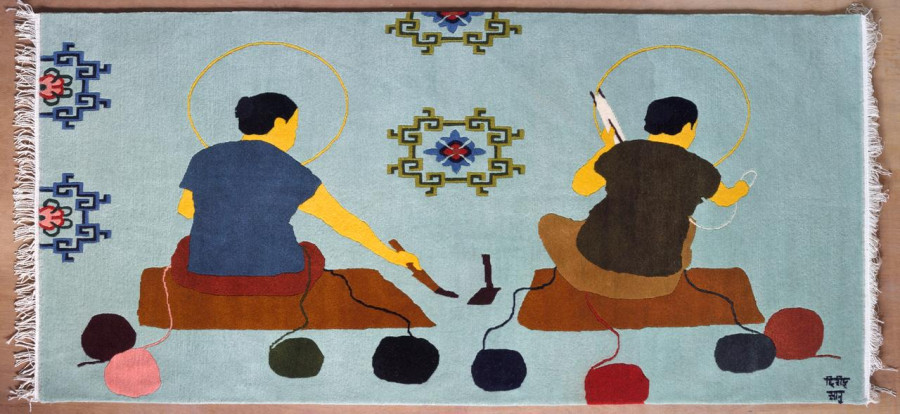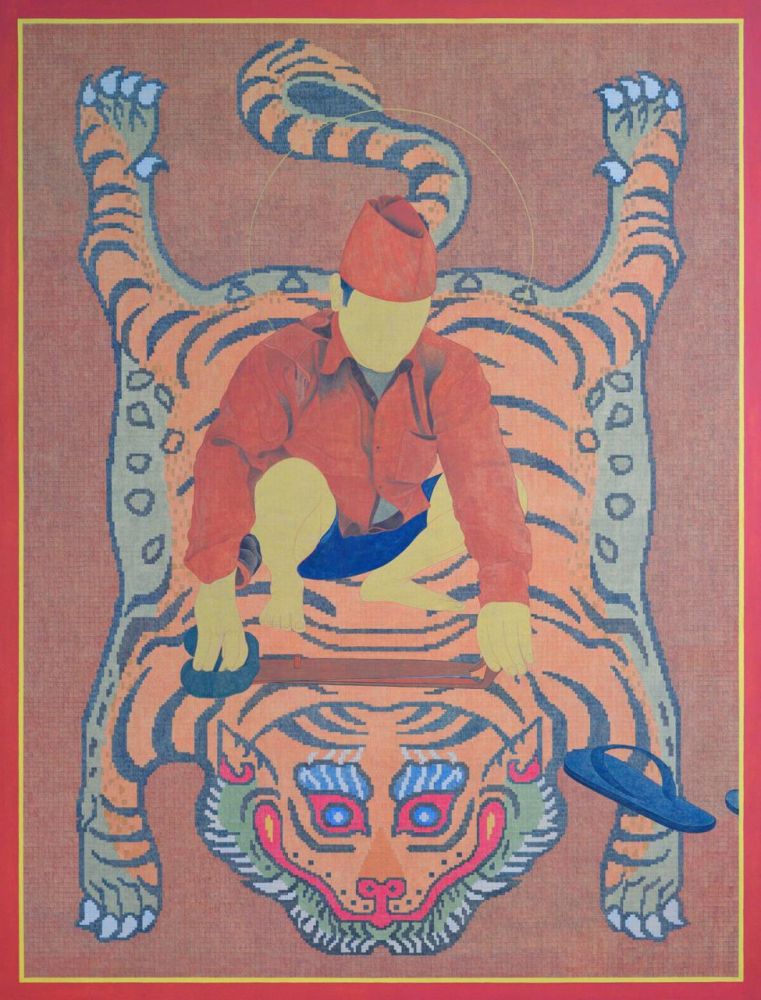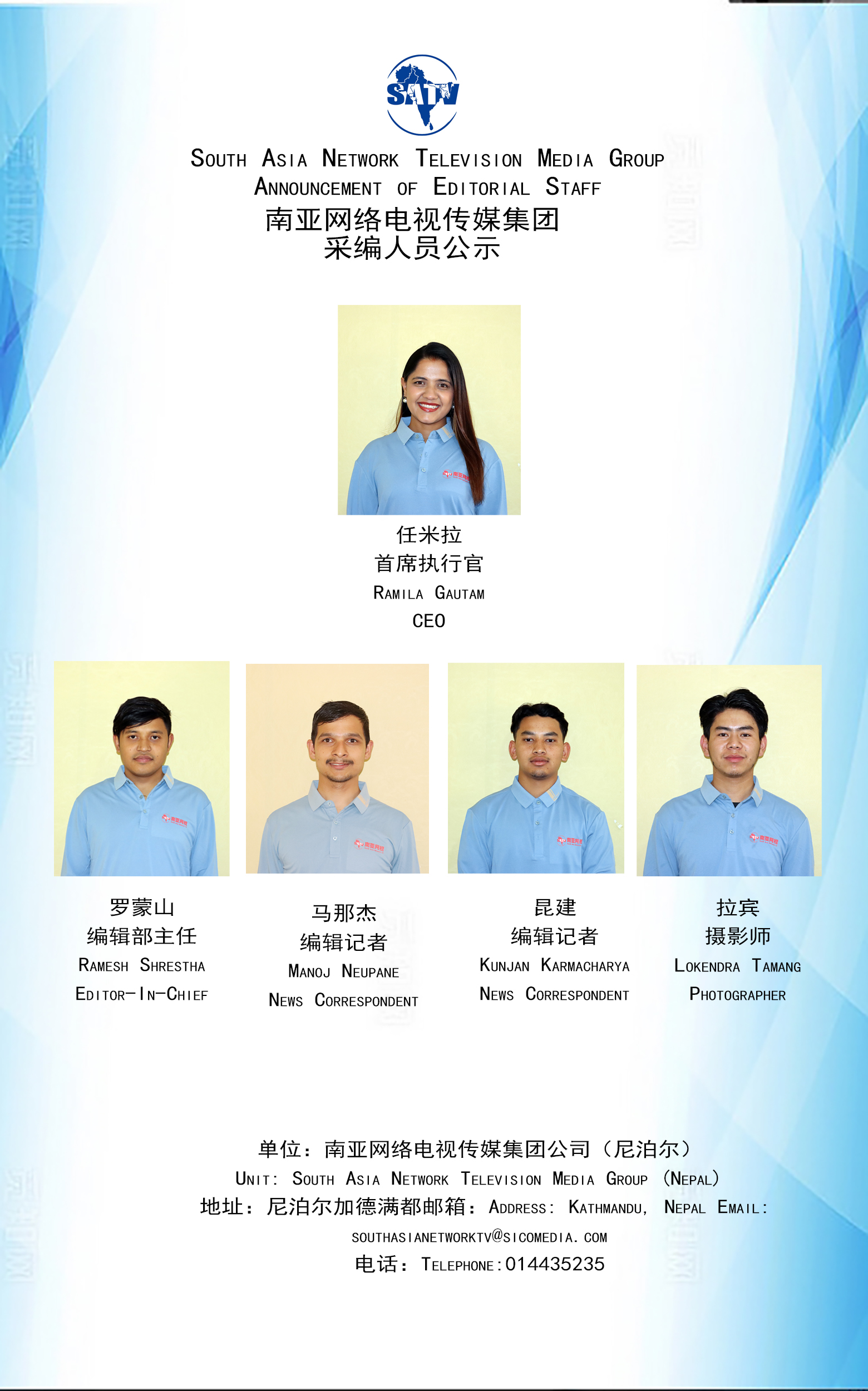
SATV Kathmandu Oct 10: ‘Tānā Bānā’, Tashi Lama’s debut solo exhibition at Siddhartha Art Gallery, aligns with the country’s current mood by not exposing its viewers to sensory bombardment—loud colours, chaotic installations, or overwhelming narratives. It offers what we need right now: quiet reflection, deliberate rhythm, and works that breathe through repetition rather than spectacle.
The exhibit unfolds as a patient meditation on the threads that tie together labour, memory, and material culture.
For Lama, the act of making art cannot be separated from the act of labour. His visual language originates from lived experience—his parents’ years of weaving in Nepal’s carpet factories. His mother, Chiring Tamang, and father, Sanu Kanchha Lama, form the emotional and conceptual foundation of his practice.
Childhood memories of looms, dyed wool, and rhythmic hand movements find new form on canvas and carpet alike. The result is a work that moves between homage and inquiry, drawing from personal history and collective heritage.
As a visual culture student, what struck me first was how Lama resists the spectacle of contemporary art. His approach feels more like an ethnographic study—an exploration of the context of labour, the composition of memory, and the texture of survival. Each piece demands slow looking; the visual rhythm echoes the tempo of weaving itself.
At the exhibit’s centre lies ‘Tana Bana’, the titular piece and the only carpet among the paintings. The medium—wool—marks a deliberate return to material origins. Designed by Lama and woven by his parents over two months, the work embodies a rare familial collaboration. Every knot, a hundred in total, functions like a unit of remembrance—loop by loop binding shared experience and intergenerational skill.
Lama’s works show the process with precision: collecting wool, dyeing it, weaving, washing, and trimming; each stage handled by different craftspeople. This careful sequencing exposes the layered composition behind a single finished carpet, revealing how collective labour sustains individual creation. Rather than glorifying the object, his work highlights the structure of production itself; the invisible systems that enable it.
The carpet’s grid-based design recalls both the weaving framework and the artist’s Thangka training. Subtle motifs—dragons, clouds, flowers—echo Tibetan iconography but function less as decoration and more as an acknowledgement of visual lineage. The surface texture, dense yet delicate, captures “the tactility of memory”—a reminder that materials, too, have histories.
This engagement with invisible labour continues in ‘The Master I’ and ‘The Master II’, works rendered in mineral pigment on cotton canvas with gold highlights. The “master” here is not the artist but the workshop coordinator who manages the logistics of weaving—providing threads, adjusting frames, and checking measurements. Lama’s focus on this figure reframes hierarchy: authority becomes care, supervision becomes collaboration.
In ‘The Master II’, familiar carpet symbols: cloud forms, hashtag-like patterns, geometric frames—appear across the composition. The gold pigment adds luminosity without opulence, creating a subtle contrast that evokes the spiritual discipline of Thangka painting. Lama’s technical precision merges with documentary intent; the painting becomes a study in how repetitive gestures produce both pattern and meaning.
A smaller companion piece depicting a single knot reinforces this conceptual framework. Isolating the smallest unit of weaving makes the invisible visible, reminding viewers that what holds entire industries together is repetition—a motif both physical and philosophical.

In ‘Serving the Craft’ and ‘White Thread’, Lama directs his gaze toward the tools themselves. Wool sits not on a shelf but upon a lotus pedestal, white thread on a throne, striking a compositional decision that shifts how we view objects of labour. The lotus, often associated with purity and spiritual awakening, here becomes a base for tools of work. Lama elevates these instruments—not by romanticising them, but by acknowledging their significance within systems of making. The work’s symbolism challenges how value is culturally assigned, especially to manual labour.
This sensibility likely stems from Lama’s years in Thangka training, where patience and reverence are integral. The controlled line work and balanced symmetry reflect that discipline, yet his subject matter departs from the divine. In Lama’s world, sanctity belongs not to deities but to those whose hands sustain craft traditions.
The series ‘Peaceful Offering (Chakati)’ extends this conversation through seven small works depicting traditional carpet motifs: coral, the three-eyed gem, rhino horn, khukuri’s sheath, insignia, and earrings. Arranged with compositional balance, these motifs operate as both cultural emblems and meditations on repetition. The rhythmic patterning mirrors the temporal flow of labor, where meaning emerges through continuity.
Nearby, an unfinished work titled ‘Wheel of Karkhana’ exposes the artist’s process. The background is detailed, while the central section remains empty, suggesting the stages of layering and revision inherent in Lama’s method. Presenting an incomplete piece feels pedagogical—it reveals not just what art becomes but how it becomes, inviting viewers into the intermediate space between concept and completion.
On the upper floor, Lama’s plant series, featuring 49 frames of allo and cotton—shifts attention from human labor to ecological interdependence. Painted using mineral and gold pigment, the leaves appear almost three-dimensional, their texture suggesting both fragility and endurance. Some canvases are intentionally left blank, introducing negative space that allows visual breathing room and compositional harmony.
These works are a visual archive of materials fundamental to Nepal’s textile history. Before imported Tibetan and New Zealand wools dominated production, fibres like allo (Girardinia diversifolia) and cotton were integral to local craft economies. As noted in the Kathmandu University Journal of Science, Engineering and Technology, “the natural fibre of allo comes from the bark of giant nettle … spun into thread and woven into various items for generations in Nepal, underscoring its deep-rooted presence in rural livelihoods.”
Similarly, an ICIMOD working paper on the ‘Allo Value Chain in Darchula’ traces how community-based weaving of allo sustained mountain economies long before imported fibres reshaped the market. Lama’s interest lies in these forgotten materials—their disappearance paralleling the decline of artisanal industries themselves. By giving these plants form and presence, he foregrounds how ecological knowledge and artistic practice are intertwined.
Two large paintings, ‘Hands of Precision’ and ‘Hands in Harmony’—focus on the gestures of making. In the former, craftsman appear enlarged, the figure is haloed by rings of light reminiscent of deity iconography. Rather than sanctify them, the halos highlight individuality and skill, positioning artisans as creators in their own right. The composition balances monumentality with intimacy, giving the viewer a sense of both the scale and precision of their labour.
In ‘Hands in Harmony’, two figures clean a carpet patterned with peacocks. Cleaning objects: buckets, detergent jars and everyday object: a gas cylinder—anchor the scene in domestic realism. The cylinder, subtle yet symbolic, gestures to the dual nature of survival and production: it powers the cleaning process while alluding to sustenance and heat. Through these mundane details, Lama situates artistic representation within the lived economy—craft not as aesthetic but as livelihood.
Near the exit stands ‘The Carding Tool’, another work where instruments of preparation, those that even out raw wool—are placed on a pedestal-like structure. The recurring motif of elevation echoes throughout the exhibition, transforming labor tools into symbols of collective endurance.
Across ‘Tānā Bānā’, Lama employs composition, texture, and symbolism to reframe craft as a site of memory and meaning. His works do not aestheticise labour but contextualise it, blending the precision of Thangka painting with the structural logic of weaving. The exhibition can be read as a form of visual ethnography, where objects and gestures stand in for unwritten histories.
Lama’s approach offers an important case study in how form operates as a social text. His art documents not individuals alone but systems of making, addressing the erasure of working-class narratives within Nepal’s modern art discourse. The communities most present in this work—Tamang, Magar, Dhimal, Tibetan—rarely appear in institutional archives. Lama’s intervention, then, is archival in spirit: to weave recognition where absence once prevailed.
On October 15 at 4:30 pm, artist Sagar Manandhar will join Lama for a conversation titled ‘Tracing the labor of hands that weave memory, survival, and silence into every carpet.’ The discussion aims to extend the exhibition’s inquiry beyond the gallery walls, situating it within broader conversations about craft, migration, and visual history.
Ultimately, ‘Tānā Bānā’ is less about nostalgia and more about noticing: the way threads, hands, and materials hold time. In a moment when speed and spectacle dominate cultural spaces, Lama’s restrained compositions invite us to slow down and listen. Stepping into this exhibit after the intensity of protest felt like returning to stillness—a reminder that art, at its quietest, can still speak of endurance.
________
Tānā Bānā (Weaving every breath)
Where: Siddhartha Art Gallery, Babermahal Revisited
When: Till October 19
Time: Sunday to Friday: 11:00 am to 5:00 pm, Saturday: 12:oo pm to 5 pm
Entry: Free











